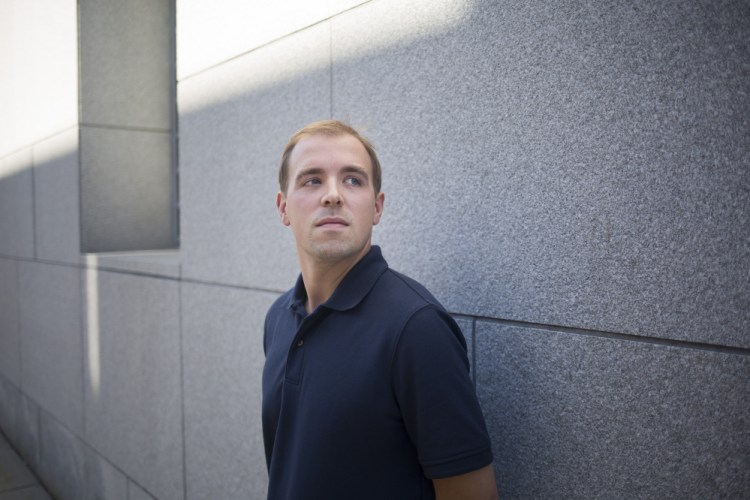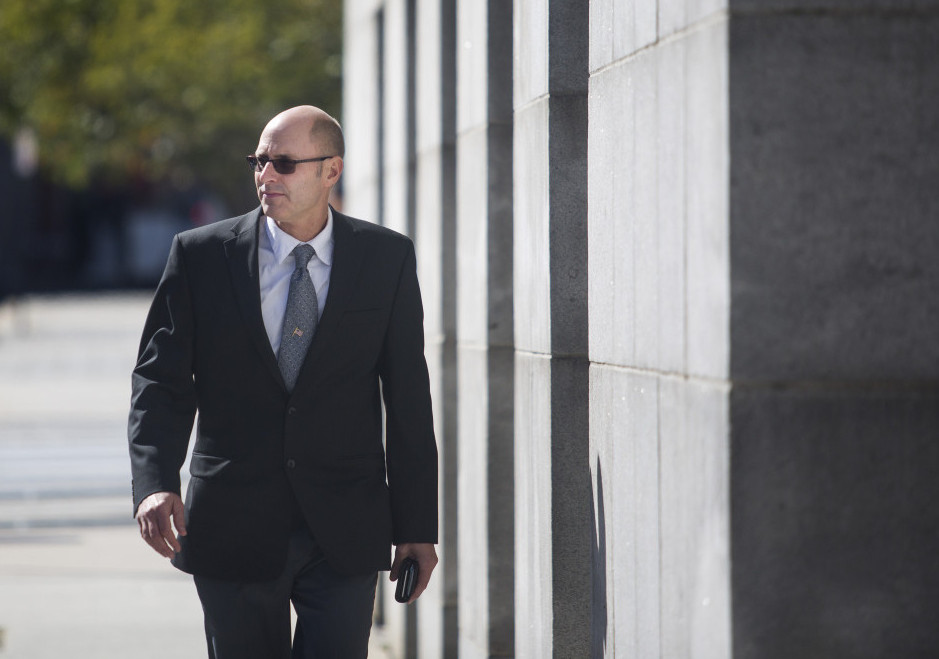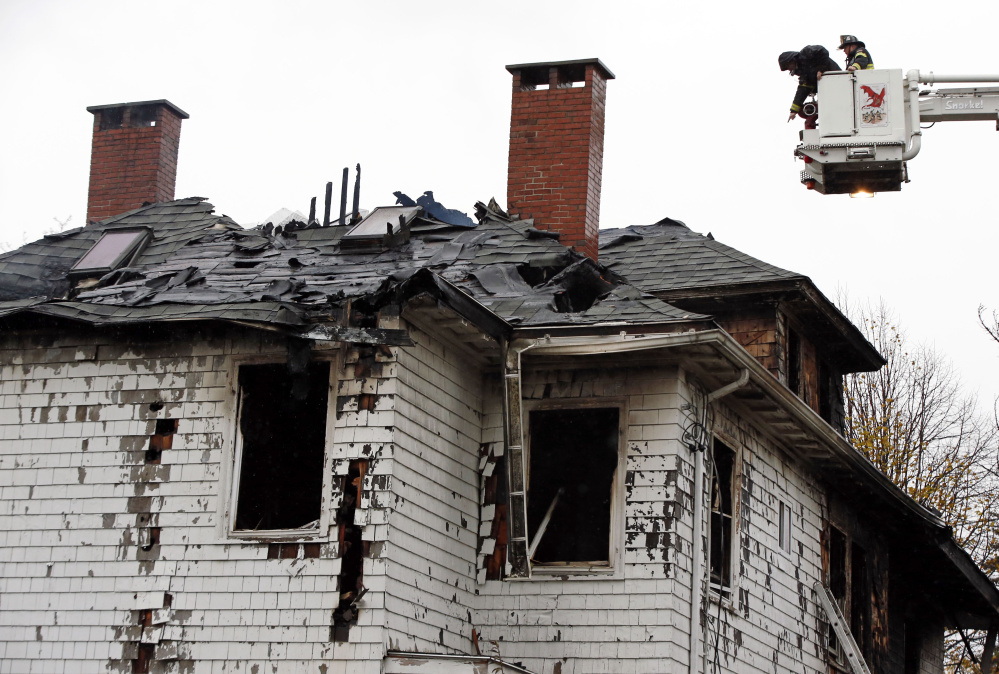Survivors of the Portland apartment building fire that killed six people testified Tuesday that a rear stairwell was blocked by a bookcase, forcing them to escape through a second-floor window as the fast-moving fire filled a hallway with smoke and heat.
“I could only see partially down the hall. There was heavy black smoke on the ceiling,” said Paul Garrido, a 25-year-old Rockland resident who was visiting friends. Garrido described hearing screams from others in the house who were trapped.
“I shut the door to the bedroom to buy us some time,” he said. “The screaming continued. When the door shut, I could hear – one girl was screaming for help and the other was just screaming.”
Landlord Gregory Nisbet is in the second day of his trial on six counts of manslaughter – one for each of the young adults killed by the early morning fire. State prosecutors continued to press their case Tuesday morning by questioning past tenants who survived the deadly Nov. 1, 2014, blaze about the condition of the building and their efforts to escape the fire.
Other potentially damaging testimony came Tuesday from a former contractor who did work on the house for Nisbet. Waldo Trott, a self-employed home remodeler, testified that he told Nisbet years ago that he thought the third-floor window was too small to be used as an emergency exit and that he noticed that the building had deteriorated and become “a slum.”
The fire was accidentally started when someone at the home improperly discarded smoking materials on the front porch.
A state prosecutor said Monday that Nisbet is responsible for the loss of life because he rented out substandard apartments that turned the rooms into “death traps.” The women heard screaming were trapped in their rooms on the third floor because they couldn’t get out windows that were too small, said Assistant Attorney General John Alsop.
Nisbet’s attorney defended the landlord’s management of the building on Monday, saying city codes allow for up to 16 people to live in a single-family home. He suggested that the victims may have been incapacitated by the heat and gases and unable to use emergency exits.
The fire’s victims included Steven Summers, 29, of Rockland, Maelisha Jackson, 23, of Topsham and Christopher Conlee, 25, of Portland, who were visiting the house. The fire also killed house residents David Bragdon Jr., 27, Ashley Thomas, 26, and Nicole Finlay, 26.
Nathan Long, who was a tenant in the building, described in court how he woke to flames outside his window and then tried to save his housemates, including three close friends who died. “I got out and they didn’t. That’s the hardest part,” Long said outside the courthouse after testifying.
NISBET’S INITIAL REACTION TO FIRE
If convicted, Nisbet would be the first landlord in the state found guilty of manslaughter for an accidental fire. Nisbet waived his right to a jury trial, so the case will be decided by Superior Court Justice Thomas Warren.
State prosecutors introduced testimony Tuesday about Nisbet’s initial reaction to the fire.
Deborah Merchant, who works at the Mid-Coast Recreational Center in Rockport, testified that Nisbet arrived late for a tennis match on the day of the fire and told her about the fire and that one person had died and other people were trying to reach him.
“I said, ‘You’re playing tennis?’ He said, ‘There’s nothing I can do,’ ” Merchant testified. She said Nisbet told her that his insurance company wouldn’t be open until Monday and that there was poor cellphone reception. She said she offered to let Nisbet use the center’s WiFi connection, but he declined.
In between matches, Nisbet also declined to allow Merchant to tell him what she had learned about the fire from online news sources, she said. After his second and final match, she told him that five people had died. It was at that point, she said, that he looked upset.
Meanwhile, testimony from survivors described the horror of what happened that morning in Portland.
Long’s second-floor bedroom overlooked the front porch. He woke up to his alarm at 7:15 a.m., around the time the fire was spreading.
“There was fire right outside of the window,” he said.
The intensity of the flames prevented him from opening the door to Bragdon’s room across the hall, Long said, and he couldn’t get down the stairs because of smoke and flames.
“I yelled ‘Fire!’ several times,” he said.
ALERTING OTHERS, RUSH TO ESCAPE
Garrido said he was sleeping on the downstairs couch when he was woken by someone screaming, “Fire!” and by the banging and popping noises of the fire.
He smelled smoke and saw the front door engulfed in flames. He grabbed his coat and overnight bag, but only had time to put on one shoe before trying to escape.
With the front door engulfed, he ran upstairs, yelling and banging on the walls to alert other residents, he said. Long ran past as Garrido got to the top of the stairs.
Long ran down the hall and shook Kyle Bozman to wake him up, then tried to clear a bookcase that was blocking a back stairwell.
With smoke and heat intensifying, Garrido, Long and Bozman climbed out the second-floor window of Bozman’s room. Long said the presence of smoke forced him to leap to the ground from the porch roof, even though he thought it was too high.
Garrido estimated it took him about 90 seconds from the time he woke up to get outside, and that he heard the women screaming for about the last 30-40 seconds. A prosecutor said Monday that the women living on the third floor – Finlay and Thomas – were trapped because there was no emergency exit. Conlee also was trapped in Finlay’s room.
DEFENSE SEES INCONSISTENCIES
Long testified Tuesday that he didn’t hear anyone screaming as he escaped the house.
He said there were no smoke detectors in the apartment and he never saw Nisbet inspect the apartment when new tenants moved in.
However, Long also said he considered all of the tenants to be a single family, even though they paid their rents separately and used padlocks on the outside of their bedroom doors. He also noted that occasionally people took up residency in the basement, and at one point in a van outside to which electricity was supplied by an extension cord.
Long said Bozman had been sleeping on the downstairs couch for about a month, while waiting for a previous tenant to remove belongings from his room. Bozman moved the items to the back stairwell a few days before the fire, he said.
During cross examination, defense attorney Matthew Nichols sought to highlight inconsistencies in Garrido’s testimony.
Nichols noted that Garrido told a deputy fire marshal that there was only one woman screaming and that it was Maelisha Jackson. He also told police that Steven Summers had jumped from a second-floor window to escape, although Summers actually ran out the front door. He was burned so badly that he died several days later.
Garrido said that, in hindsight, he should not have speculated about who was screaming and that he did not know for sure how Summers escaped.
During the graphic testimony, Summers’ mother wiped away tears and was comforted by Ashley Summers, Steven’s widow.
In his cross-examinations, Nichols also highlighted that Long and Garrido considered themselves sober when they went to bed, making it easier for them to escape.
“So you saw and heard a dangerous situation and you reacted quickly,” Nichols said to Garrido, who agreed.
NO ESCAPE THROUGH SMALL WINDOWS
Several pieces of testimony Tuesday focused on the size of the third-floor windows and whether the three women might have been able to escape after the stairwell was engulfed in flames.
Trott, the home remodeler, said Nisbet brushed off his concerns about the window size when he brought it up in late 2007 or early 2008. At the time, Trott was rebuilding the back porches of the house as well as doing regular maintenance.
“I didn’t know anybody was up there. I just thought they were small,” he said, estimating that the windows were 2 feet wide by 3 feet tall. Only half of the windows could be opened at a time.
Trott, who stopped working for Nisbet about a year after discussing the small windows, also said he noticed the condition of the house deteriorate over time. “It went from pristine to what I say is a slum,” Trott said.
Kerey Swann and Shanna Lynn Fratini, who occupied the third-floor bedrooms at different times before the fire, testified that each bedroom window only opened about 8 inches and that it would have been difficult, if not impossible, to climb out of them. Swann, who lived at 24 Noyes St. for nearly two years before moving out in July 2014, testified that he saw a rope ladder that was still in its box in one of the bedrooms. Nisbet had told a fire investigator he gave rope ladders to the third-floor tenants.
ROOMING HOUSE OR SINGLE FAMILY?
A state prosecutor argued during the first day of the trial Monday that Nisbet operated the building as a rooming house without the necessary fire alarms or emergency exits. Alsop, the prosecutor, also said Nisbet deferred maintenance on the building after he stopped paying his mortgage in 2011 and faced foreclosure. Alsop said that although Nisbet continued to collect rent and take on new tenants, he did not conduct regular inspections that would have revealed a lack of smoke detectors and the blocked rear stairwell.
Nichols, however, argued that Nisbet was running the duplex as two single-family homes and that the building did not meet the definition of a rooming house.
Nichols also suggested Monday that victims were quickly incapacitated by heat and gas and would have been unable to escape even though they may have been alive as the fire spread through the house.
A fire consultant from the U.S. Bureau of Alcohol, Tobacco, Firearms and Explosives gave the court a detailed accounting of the timeline of the fire. He said heat and gases reached the third floor in less than a minute after the front door was opened by Summers as he tried to escape.
Send questions/comments to the editors.







Comments are no longer available on this story